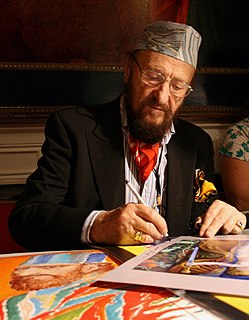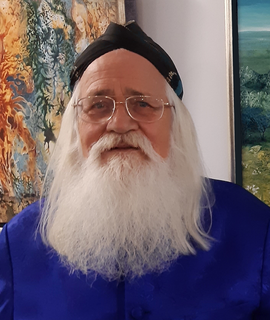
Salvador Domingo Felipe Jacinto Dalí i Domènech, 1st Marquess of Dalí de Púbol was a Spanish surrealist artist renowned for his technical skill, precise draftsmanship, and the striking and bizarre images in his work.

Wolf Vostell was a German painter and sculptor, considered one of the early adopters of video art and installation art and pioneer of Happenings and Fluxus. Techniques such as blurring and Dé-coll/age are characteristic of his work, as is embedding objects in concrete and the use of television sets in his works. Wolf Vostell was married to the Spanish writer Mercedes Vostell and has two sons, David Vostell and Rafael Vostell.

Ernst Fuchs was an Austrian painter, draftsman, printmaker, sculptor, architect, stage designer, composer, poet, singer and one of the founders of the Vienna School of Fantastic Realism. In 1972, he acquired the derelict Otto Wagner Villa in Hütteldorf, which he restored and transformed. The villa was inaugurated as the Ernst Fuchs Museum in 1988.

Rudolf Hausner was an Austrian painter, draughtsman, printmaker and sculptor. Hausner has been described as a "psychic realist" and "the first psychoanalytical painter".

Anton Lehmden was an Austrian painter, draughtsman, and printmaker.

Fantastic art is a broad and loosely defined art genre. It is not restricted to a specific school of artists, geographical location or historical period. It can be characterised by subject matter – which portrays non-realistic, mystical, mythical or folkloric subjects or events – and style, which is representational and naturalistic, rather than abstract – or in the case of magazine illustrations and similar, in the style of graphic novel art such as manga.

Arik Brauer was an Austrian painter, printmaker, poet, dancer, singer-songwriter, stage designer, architect, and academic teacher.
De Es Schwertberger, commonly known simply as De Es, is an Austrian artist, painter and modeller. His work has been shown in exhibitions in New York City, where he lived for a short time, and Switzerland.
Louis Pauwels was a French journalist and writer.
Robert Venosa was an American artist who resided in Boulder, Colorado, USA. He studied with what are termed the New Masters. His artworks reside in collections around the world.

Peter Gric or Petr Gric is Austrian painter, drawer and illustrator originally from Czech Republic. In his art appear motives of futuristic landscapes and architecture, biomechanical surrealism and fantastic realism. Gric is member of the art groups Libellule and Labyrinthe.

Laurence Caruana is a Maltese artist, writer, and lecturer noted for his contribution to the contemporary visionary art movement, particularly through his Manifesto of Visionary Art.

La Nuit fantastique is a 1942 French fantasy film directed by Marcel L'Herbier. It is regarded as one of the most successful films made in France during the German occupation.

The Scharf-Gerstenberg Collection is an art museum in Berlin. Its collection of paintings, graphics and sculptures, spanning the period from French Romanticism to Surrealism, is currently housed in former rooms of the Egyptian Museum in Charlottenburg on a ten-year loan. It was founded in 2008, and is part of the National Gallery of Berlin.
Art-Club was an association of artists during the postwar period in Vienna, Austria, in 1946–1959.
Baruch Elron or Barbu Teodorescu (1934–2006) was an Israeli painter best known for his unique Fantastic Realist style rich in symbols and allegories.

Erwin Pfrang is a German painter and printmaker.

Gert Chesi is an Austrian photographer, author, journalist and filmmaker. At the end of the 1970s he became internationally famous after publishing the book Last Africans, which was translated into six languages. In 1995 Gert Chesi founded the Haus der Völker in Schwaz, which is a museum for tribal art and ethnography.

Egon Rusina Moroder is an Italian painter and illustrator from South Tyrol. He lives with his wife and daughter in Ortisei.

Wolfgang Maria Ohlhäuser is a German painter.






















